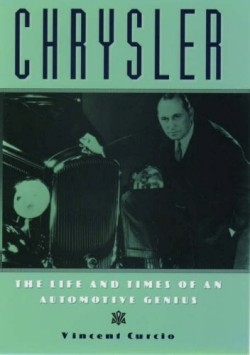Chrysler
The Life and Times of An Automotive Genius
“We thank Thee, O God, for all the goodness and courage which have passed from the life of thy servant, Walter Perry Chrysler, into the lives of others, and have left the world richer for his presence,” said Reverend Underwood on August 20, 1940. Forty-nine honorary pallbearers carried the huge bronze casket to the waiting black Chrysler Imperial hearse for the ride to Sleepy Hollow Cemetery in Tarrytown, New York.
In Chrysler Curcio creates a testament to one of the leaders of the automobile industry and to the man himself in time for Chrysler Corporation’s seventy-fifth anniversary in June. Curcio divides his book into three parts. “The Early Years” describes Chrysler’s boyhood and rise as a machinist and manager in the railroad industry. “The Automobile and The Assembly Line” delineates early automobile history and the development of mass production. “The Greatness” details the assembly of Chrysler Corporation. The book is richly fueled with anecdotes and provides a trunk full of delightful details and vignettes of vintage automobile men.
Chrysler was born in Kansas in 1875. The son of a locomotive engineer on the Union Pacific railroad and an iron willed mother who didn’t hesitate to use hairbrush persuasion. While selling milk for his mother he learned to keep a small account book. Later, when he became “a manufacturer he would keep small but precisely detailed cost books in his jacket pocket,” says Curcio, to be always aware of costs.
After high school Chrysler became a machinist for Union Pacific, as he was interested in the “mysteries of the locomotive.” He once made a depth gauge, which enabled a plug to be fitted efficiently the first time. From this he learned the lessons of standardization of machines and labor that would prove useful in the automobile industry. Chrysler also learned how to set valves, critical for the pulling power of a locomotive, and once fixed a blown out back cylinder in an emergency situation, winning accolades from his boss.
At the age of thirty-two he became a superintendent of motive power, the youngest man to reach that position in U. S. railroad history. One man said, “Chrysler was a jack of all trades. What made him different was that he was also a master of them.” His last job in the locomotive industry was in 1912 as works manager for the American Locomotive Company.
In 1912 Buick Motor needed an experienced machinery man. Chrysler had been interested in automobiles ever since buying a Locomobile in 1908, disassembling and assembling it more than forty times. He visited the Buick factory, saw a hundred opportunities for improvement and was hired as works manager.
At the crossroads of Chrysler’s career, Curcio provides a compact history of the automobile industry to 1912. He includes the development of engines and automobiles, assembly lines and mass production and mini histories of automobile men and companies.
Chrysler was successful at Buick and became its president in 1916 with a salary of $500,000 per year. He had turned Buick into the third largest auto company. In 1920 the ailing Willys-Overland Company offered Chrysler one million dollars per year. A year later Chrysler was asked to rescue the Maxwell-Chalmers Company.
The first Chrysler car was made in 1923, a truly engineered car, and in 1925 the Maxwell Company was transformed into the Chrysler Corporation. 1928 was a year of milestones. Dodge Brothers was acquired enabling Chrysler Corporation to go from assembling cars to manufacturing them making Chrysler the third largest automobile company in the world. The highly successful Plymouth was introduced and Chrysler announced that he would build the Art Deco styled Chrysler Building in New York City.
In 1934 the Chrysler Airflow was produced. It was the first mass-produced car that was streamlined and felt modern to ride. Unfortunately, people were not ready for the design. One person thought it had “rhinocerine ungainliness.” It became known as the biggest failure in American automobile history until the Edsel arrived.
After Buick in 1920, Chrysler moved with his wife and three children from Flint, Michigan, to King’s Port on Long Island Sound. He lived in a French Renaissance style mansion with twenty-three rooms on twelve acres of lawns and gardens. There was a swimming pool inside and out. His yacht, the Frolic, was moored at water’s edge. He had the aura of Jay Gatsby. Chrysler retired in 1935 and in 1938 had a stroke.
Curcio’s Michener-sized book is written comfortably like cocktail party chat and never exhausts the reader. He might have included too many extraneous details, however, such as train robber Tom Ketchum’s head being torn off when he was hung and the apocryphal story that anti-semitic Henry Ford had a stroke upon viewing the horror of the opening of concentration camps.
Chrysler is a tribute to the man and his industry.
Reviewed by
Alex Moore
Disclosure: This article is not an endorsement, but a review. The publisher of this book provided free copies of the book to have their book reviewed by a professional reviewer. No fee was paid by the publisher for this review. Foreword Reviews only recommends books that we love. Foreword Magazine, Inc. is disclosing this in accordance with the Federal Trade Commission’s 16 CFR, Part 255.


